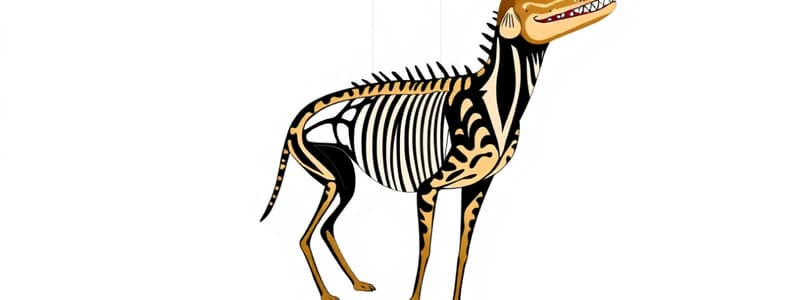Podcast
Questions and Answers
What is the primary function of the notochord in chordates?
What is the primary function of the notochord in chordates?
- To develop into the respiratory system
- To provide support (correct)
- To connect the nervous system
- To serve as a digestive tract
Which subphylum includes animals that retain all chordate characteristics throughout their life?
Which subphylum includes animals that retain all chordate characteristics throughout their life?
- Urochordata
- Vertebrata
- Cephalochordata (correct)
- Arthropoda
What is a characteristic feature of the subphylum Vertebrata?
What is a characteristic feature of the subphylum Vertebrata?
- Lack of a centralized nervous system
- Presence of pharyngeal slits
- The presence of a backbone (correct)
- Absence of a post-anal tail
What role do chordates play in their ecosystems?
What role do chordates play in their ecosystems?
Which of the following is NOT a characteristic of chordates?
Which of the following is NOT a characteristic of chordates?
What is a key adaptation of birds belonging to the class Aves?
What is a key adaptation of birds belonging to the class Aves?
In which type of environments can chordates be found?
In which type of environments can chordates be found?
Which of the following classes includes frogs and salamanders?
Which of the following classes includes frogs and salamanders?
Flashcards are hidden until you start studying
Study Notes
Overview of Chordata
- Phylum Chordata includes animals with certain key features at some stage of development.
Key Characteristics
-
Notochord:
- A flexible rod-like structure providing support.
- Present at some stage in all chordates.
-
Dorsal Hollow Nerve Cord:
- Develops into the central nervous system (brain and spinal cord).
-
Pharyngeal Slits:
- Openings in the throat region.
- Function varies among groups (e.g., gills in fish, jaw structures in tetrapods).
-
Post-anal Tail:
- Extends beyond the anus.
- May be reduced in some species.
Major Subphyla
-
Cephalochordata:
- Example: Lancelets.
- Small, fish-like marine animals.
- Retain all four chordate characteristics throughout life.
-
Urochordata:
- Example: Tunicates or sea squirts.
- Larval stage possesses all four characteristics; adults typically lose most.
-
Vertebrata:
- Distinctive features include a backbone or vertebral column.
- Highly developed nervous systems and complex organ systems.
- Divided into several classes:
- Fish: Include jawless (e.g., lampreys), cartilaginous (e.g., sharks), and bony fish.
- Amphibia: E.g., frogs and salamanders; have both aquatic and terrestrial phases.
- Reptilia: E.g., snakes, lizards; characterized by scaly skin and eggs with protective shells.
- Aves: Birds; adaptations for flight, including feathers and hollow bones.
- Mammalia: Mammals; characterized by mammary glands and fur/hair.
Evolutionary Significance
- Chordates are a diverse group with significant evolutionary adaptations.
- Vertebrates dominate in size and ecological impact.
- Key developments in the evolution of chordates include the transition from water to land.
Habitat and Distribution
- Chordates occupy various environments, including:
- Oceans, freshwater systems, terrestrial habitats.
- Exhibit a wide range of reproductive strategies (e.g., oviparous, viviparous).
Importance in Ecosystems
- Play critical roles as predators, prey, and competitors.
- Important for ecological balance and biodiversity.
- Serve as indicators of environmental health.
Overview of Chordata
- Phylum Chordata consists of animals that exhibit key developmental features at some stage.
Key Characteristics
- Notochord:
- A flexible support rod present in all chordates at some stage, pivotal for structural support.
- Dorsal Hollow Nerve Cord:
- Develops into the central nervous system, including the brain and spinal cord.
- Pharyngeal Slits:
- Throat region openings that serve various functions; gills in aquatic forms, and contribute to jaw formation in tetrapods.
- Post-anal Tail:
- An extension beyond the anus, often reduced in some species during evolution.
Major Subphyla
- Cephalochordata:
- Includes lancelets, small marine organisms that retain all four chordate features throughout their lives.
- Urochordata:
- Comprises tunicates or sea squirts, where larval forms exhibit all four characteristics, while adults usually lose most.
- Vertebrata:
- Defined by a backbone or vertebral column and advanced organ systems. Classes include:
- Fish: Ranges from jawless (lampreys) to cartilaginous (sharks) and bony fish.
- Amphibia: Frogs and salamanders that transition between aquatic and terrestrial life.
- Reptilia: Snakes and lizards, distinguishable by scaly skin and protective egg shells.
- Aves: Birds with adaptations for flight, including feathers and hollow bones.
- Mammalia: Animals characterized by mammary glands and fur or hair.
Evolutionary Significance
- Chordates represent a diverse evolutionary lineage with pivotal adaptations, such as the transition from aquatic to terrestrial environments.
- Vertebrates dominate in size and ecological roles, influencing ecosystems significantly.
Habitat and Distribution
- Chordates thrive in diverse environments, including oceans, freshwater systems, and terrestrial habitats.
- Exhibit varied reproductive strategies, ranging from laying eggs (oviparous) to live births (viviparous).
Importance in Ecosystems
- Chordates play essential roles as predators, prey, and competitors within ecosystems.
- They contribute to ecological balances and are key indicators of environmental health and biodiversity.
Studying That Suits You
Use AI to generate personalized quizzes and flashcards to suit your learning preferences.




